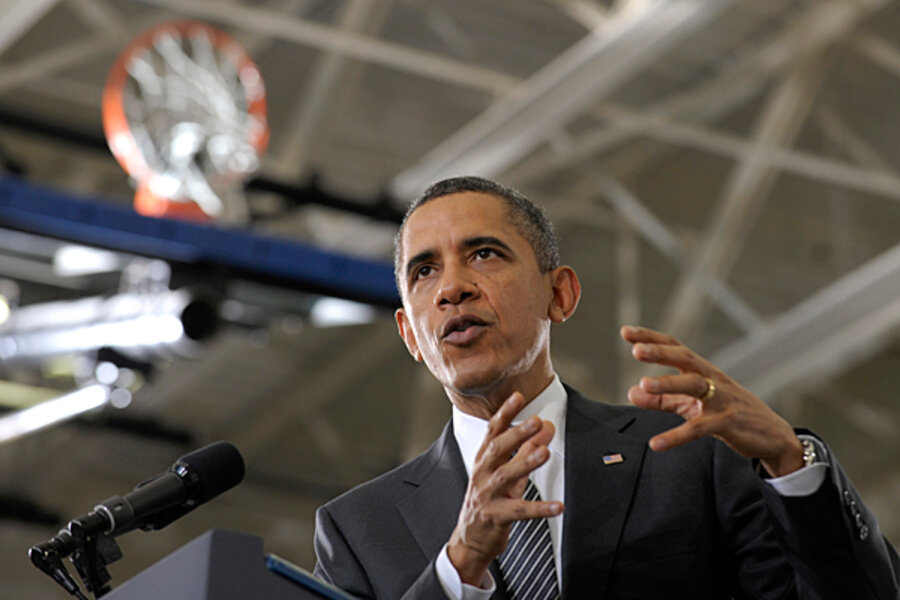Does Obama blueprint reduce budget deficit fast enough?
Loading...
President Obama proposed a federal budget plan Monday that would avoid tax hikes on most Americans, but that leaves his administration open to criticism that it is moving too slowly to tame massive annual deficits.
The Obama plan for 2013 and beyond calls for federal spending to fall from currently projected levels, and for taxes to rise for high-income households. But the White House also argues that trying to reduce US deficits too fast would harm a still-tentative economic recovery.
If enacted, the budget as envisioned by the president would result in a federal deficit of $901 billion in the 2013 fiscal year (which begins in October), after deficits above $1 trillion during each of the previous four years. The deficit would fall from 5.5 percent of gross domestic product in 2013 to 2.7 percent of GDP in 2018, the White House projects.
Even in 2018, that would barely bring the deficit into a range that credit-rating firms view as tolerable, for the US to maintain a strong rating on its public debts. It would leave the nation vulnerable if the economic performance doesn't match Mr. Obama's expectations over the next few years, or if, as many forecasters expect, the cost of health-care entitlements grow quickly after 2018, as the baby-boom retirement wave gathers momentum.
The White House budget document is both a road map of presidential priorities – calling for boosts in some education, transportation, and energy programs while cutting military spending – and an election-year political statement. It's not expected to pass a politically divided Congress, but Obama and his team say it takes a "balanced" approach to deficit reduction and economic growth that differs sharply from Republican visions.
"I think there is pretty broad agreement that the time for austerity is not today," said Jacob Lew, Obama's chief of staff, said in TV appearances Sunday, according to the Associated Press. "Right now we have an economy that's taking root.... Austerity measures right now would take the economy in the wrong way."
In his radio address Saturday, Obama called on Congress to extend a key part of his program for US job growth: a temporary payroll-tax cut (due to expire at the end of February) to boost the economy by keeping more income in workers' pockets. On Monday, as the budget document was being relayed to Congress, Obama pitched more funding to help community colleges boost the job skills of American workers.
"At a time when our economy is growing and creating jobs at a faster clip, we've got to do everything we can to keep [recovery] on track," Obama said at a community college in Annandale, Va. Businesses are looking for the workers with the best skills, he said, and "I don't want them to find them in India or China."
Republicans in Congress fired back with their view that Obama's budget, by raising taxes on the wealthy and not doing more to rein in spending, will damage the economy. They also say Obama is falling short of his own of his own goal of cutting the deficit in half within four years of taking office.
"The Democrats’ spending addiction is all the more alarming considering that America’s economy remains weak and the nation’s growing debt burden poses a serious threat to job-creation and economic growth," the National Republican Congressional Committee said in a statement issued Monday.
Like any budget numbers, Obama's forecasts of budget deficits depend heavily on uncertain assumptions about economic growth. The White House expects real GDP, after inflation, to run at a strong pace of about 4 percent for the three years from 2015 to 2017, before falling to what economists see as a more normal pace for the US a bit below 3 percent by 2019.
If those numbers prove to be too optimistic, the budget challenges would become tougher to resolve as the decade progresses.
Some highlights of the Obama budget proposal:
•Deficit reduction would total $1.1 trillion over the next 10 years, excluding savings from a drawdown of military operations in Iraq and Afghanistan and from not extending Bush tax cuts for high-income earners. Two-thirds of this deficit reduction is from spending cuts.
•Nondefense discretionary spending would fall over time as a percentage of GDP, and the budget brings defense spending down to zero real growth, with $78 billion in spending cuts over the next five years.
•The deficit of 5.5 percent of GDP in 2013 would be considerably smaller – but not half – of the deficit inherited by Obama during the 2009 fiscal year (10.1 percent of GDP).
•The nation's publicly issued debt would rise to 77 percent of GDP in 2017, up from 74 percent in 2012 and 54 percent in 2009. Defenders of the president says this shows Obama's fiscal plan is making progress toward stabilizing debt as a share of GDP, albeit with further efforts to control health-care costs still needed. Obama's critics say this forecast may prove too rosy, and that the debt will be a drag on economic growth unless policymakers start bringing it down as a share of GDP.





